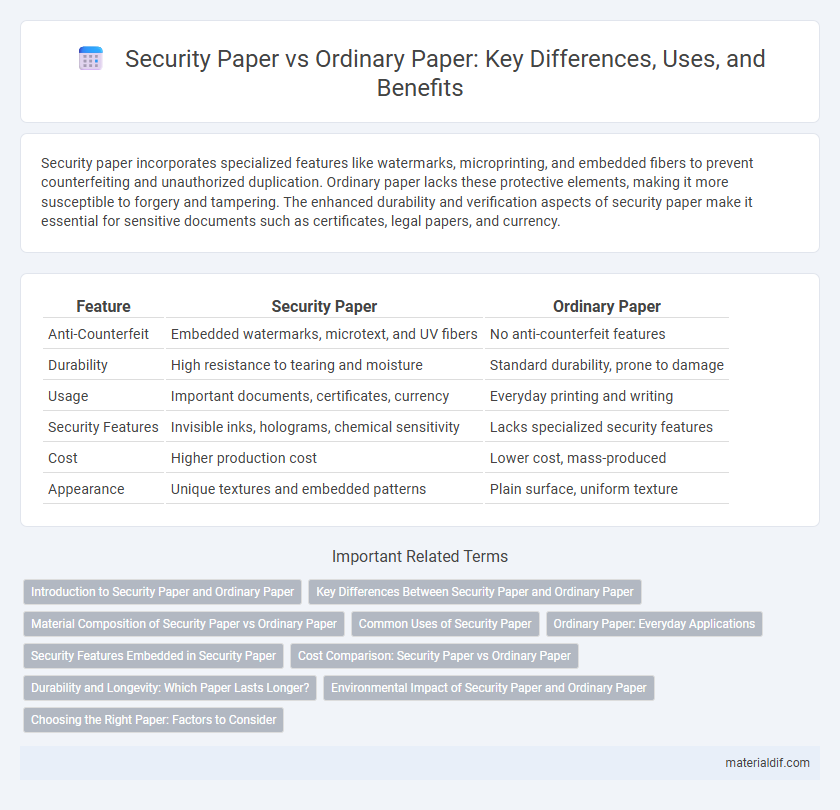Security paper incorporates specialized features like watermarks, microprinting, and embedded fibers to prevent counterfeiting and unauthorized duplication. Ordinary paper lacks these protective elements, making it more susceptible to forgery and tampering. The enhanced durability and verification aspects of security paper make it essential for sensitive documents such as certificates, legal papers, and currency.
Table of Comparison
| Feature | Security Paper | Ordinary Paper |
|---|---|---|
| Anti-Counterfeit | Embedded watermarks, microtext, and UV fibers | No anti-counterfeit features |
| Durability | High resistance to tearing and moisture | Standard durability, prone to damage |
| Usage | Important documents, certificates, currency | Everyday printing and writing |
| Security Features | Invisible inks, holograms, chemical sensitivity | Lacks specialized security features |
| Cost | Higher production cost | Lower cost, mass-produced |
| Appearance | Unique textures and embedded patterns | Plain surface, uniform texture |
Introduction to Security Paper and Ordinary Paper
Security paper incorporates specialized features such as watermarks, embedded fibers, and chemical-sensitive coatings to prevent forgery and unauthorized replication. Ordinary paper lacks these anti-counterfeiting elements, making it vulnerable to tampering and duplication. The distinct physical and chemical properties of security paper provide enhanced protection for sensitive documents in financial, legal, and official applications.
Key Differences Between Security Paper and Ordinary Paper
Security paper incorporates embedded features such as watermarks, microprinting, and ultraviolet fibers to prevent counterfeiting and unauthorized duplication. Ordinary paper lacks these advanced security elements, making it vulnerable to forgery and tampering. The durability and specialized coatings in security paper also enhance protection against alteration and fraud compared to standard paper.
Material Composition of Security Paper vs Ordinary Paper
Security paper is composed of specialized fibers such as cotton and synthetic blends, often combined with embedded security features like watermarks and fluorescent threads, enhancing durability and counterfeit resistance. Ordinary paper primarily consists of wood pulp fibers without integrated security elements, making it more prone to wear and forgery. The use of chemically treated fibers in security paper also imparts resistance to tampering and chemical alterations.
Common Uses of Security Paper
Security paper is designed with advanced features such as watermarks, microprinting, and security fibers to prevent counterfeiting and unauthorized duplication. Common uses of security paper include printing currency, legal documents, certificates, and sensitive financial paperwork where authenticity and tamper-evidence are critical. Unlike ordinary paper, security paper offers enhanced protection against fraud and forgery, ensuring the integrity of important documents.
Ordinary Paper: Everyday Applications
Ordinary paper is widely used for everyday applications such as printing, writing, and packaging due to its affordability and accessibility. Unlike security paper, ordinary paper lacks embedded features like watermarks or security threads, making it unsuitable for protecting sensitive documents. Its versatility supports routine tasks in offices, schools, and homes, but it offers minimal protection against forgery or tampering.
Security Features Embedded in Security Paper
Security paper incorporates embedded features such as watermarks, security threads, microprinting, and UV-reactive fibers that significantly enhance document authenticity and prevent counterfeiting. These specialized elements are integrated during the manufacturing process, making tampering or duplication extremely difficult compared to ordinary paper. As a result, security paper is essential for sensitive documents like currency, certificates, and legal papers where integrity and verification are critical.
Cost Comparison: Security Paper vs Ordinary Paper
Security paper carries a higher production cost due to embedded features like watermarks, holograms, and chemical coatings designed to prevent counterfeiting, whereas ordinary paper is cheaper to manufacture and widely used for general purposes. The cost differential significantly impacts bulk purchases, making security paper a more expensive option for businesses requiring enhanced document protection. Despite the higher upfront expense, security paper reduces potential financial losses related to fraud and forgery, offering a cost-effective solution for sensitive or legal documentation.
Durability and Longevity: Which Paper Lasts Longer?
Security paper is engineered with specialized fibers and watermarks that significantly enhance its durability and resistance to wear compared to ordinary paper. Its longevity is superior due to embedded features that prevent fading, tearing, and unauthorized reproduction, making it ideal for official documents. Ordinary paper, typically made from lower-quality pulp, deteriorates faster under environmental stress, limiting its lifespan.
Environmental Impact of Security Paper and Ordinary Paper
Security paper significantly reduces environmental impact by incorporating recycled fibers and eco-friendly inks, lowering resource consumption during production compared to ordinary paper. Ordinary paper manufacturing often leads to higher carbon emissions and excessive water use due to the intensive processing of virgin wood pulp. The advanced production methods for security paper promote sustainability by minimizing waste and supporting responsible forestry practices.
Choosing the Right Paper: Factors to Consider
Security paper features embedded anti-counterfeiting measures such as watermarks, microtext, and chemical reagents, which prevent fraud and enhance document authenticity. Ordinary paper lacks these protective elements, making it suitable only for everyday printing but vulnerable to tampering or forgery. When selecting the right paper, consider the intended use, required security level, and cost-effectiveness to ensure optimal protection against document falsification.
Security paper vs Ordinary paper Infographic

 materialdif.com
materialdif.com